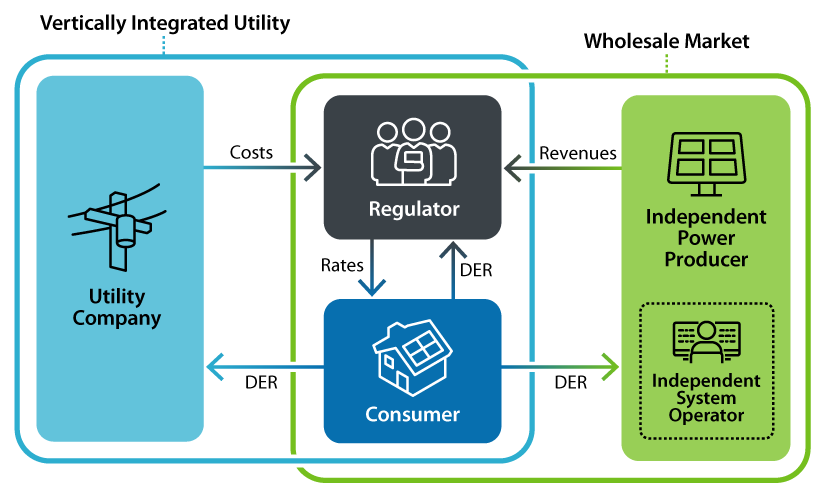HEM: Holistic Electricity Model
NLR's Holistic Electricity Model (HEM) is an iterative framework that explores all stakeholder viewpoints in the analysis of evolving electricity systems.
The primary purpose of HEM is to gain insights into how structural electricity system changes impact an interconnected energy ecosystem both as a whole and from the perspectives of different stakeholders.
Novel Stakeholder-Centric Energy Modeling

Electricity system planning has traditionally been conducted from the perspective of a single central planner, with limited consideration for other stakeholders, such as suppliers, regulators, and consumers. Recent and ongoing technological, market and policy innovations, however, have created a growing and diverse landscape of electricity systems throughout the United States and the world. Because of these developments, questions have been raised regarding the structure of future electricity systems. For instance, how decentralized will generation and other grid services become? And to what degree might customers or communities choose total or partial self-supply?
HEM answers these questions with a decentralized, stakeholder-centric approach that incorporates multiple perspectives to ensure that all members of an electricity system are considered as the structure evolves.
The HEM framework does so by modeling each stakeholder’s behavior as an optimization program or as a system of equations all implemented with the Julia programming language. This allows the model to iterate between the perspectives of multiple stakeholder types, each of which has distinct decisions to make and may approach the decision-making process differently. For example, a regulator may approve retail electricity rates computed using a pro forma system of equations, while an independent power producer may compute optimal, profit-maximizing investment decisions.
HEM, therefore, provides a flexible tool for energy planners to gain insights into how structural changes may impact an entire electricity ecosystem.
Applications
HEM analysis can be used to explore the effects of a variety of structural changes in electricity systems evolution.
Distributed Photovoltaics

The HEM framework is initially being applied in a case study of distributed photovoltaics (DPV) adoption in a bulk power system composed of natural gas and utility-scale photovoltaic generators. Researchers are exploring the interactions of regulatory structure, retail rate design, and DPV compensation, as well as their impacts on utility-scale investments, customer investments, retail rates, and net surpluses.
Additional Applications
HEM is designed to address structural questions in an integrated way that is open to the inclusion of new types of stakeholders, outcome metrics, and decision-making processes. The framework can be applied to multiple jurisdictions and is extensible for many different timeframes, technologies, and use cases.
Technical Review Committee
The HEM team has partnered with a diverse technical review committee that reflects many of the stakeholder voices factored into the modeling itself. Although these representatives have offered input throughout the project, any results and findings do not necessarily reflect their opinions or the opinions of their institutions.
The committee includes representatives from Renewable Energy Buyers Alliance, Fort Collins Utilities, the World Resources Institute, Electron, the California Office of Ratepayer Advocates, Southern Company, New Buildings Institute, WSP, ISO New England, Kevala Inc., the University of Wisconsin, the University of Maryland, Johns Hopkins University, Loughborough University, Penn State University, Carnegie Mellon University, University College Dublin, and American University.
Future Development Plans
Open-Source Software
Open-source HEM software is being developed with plans to eventually release it on Github. The Holistic Electricity Modeling framework is associated with the Scalable Integrated Infrastructure Planning (SIIP) initiative.
Collaborations
HEM is a flexible framework that can be extended to represent many different stakeholder types, timeframes, technologies, jurisdictions, and use cases. Are you interested in future collaboration with our team or an open discussion of the model’s capabilities? Reach out to Elaine Hale.
Publications
Integrated, Multi-Stakeholder Analysis of Electricity System Structures: Methodology and a Case Study, IEEE Transactions on Energy Markets, Policy and Regulation (2023)
Maximizing Distributed Energy Resource Value for All Stakeholders, NLR Technical Report (2020)
Contact
Elaine Hale
Share
Last Updated Dec. 6, 2025
